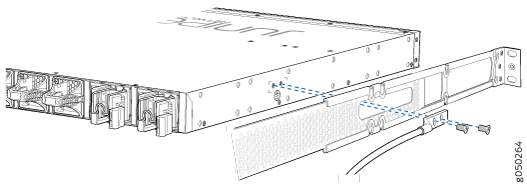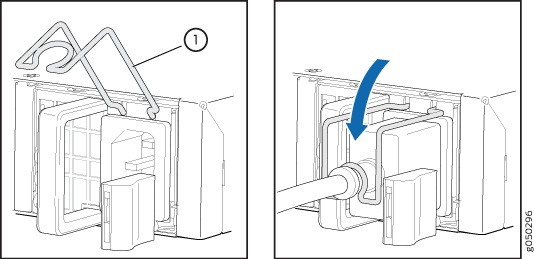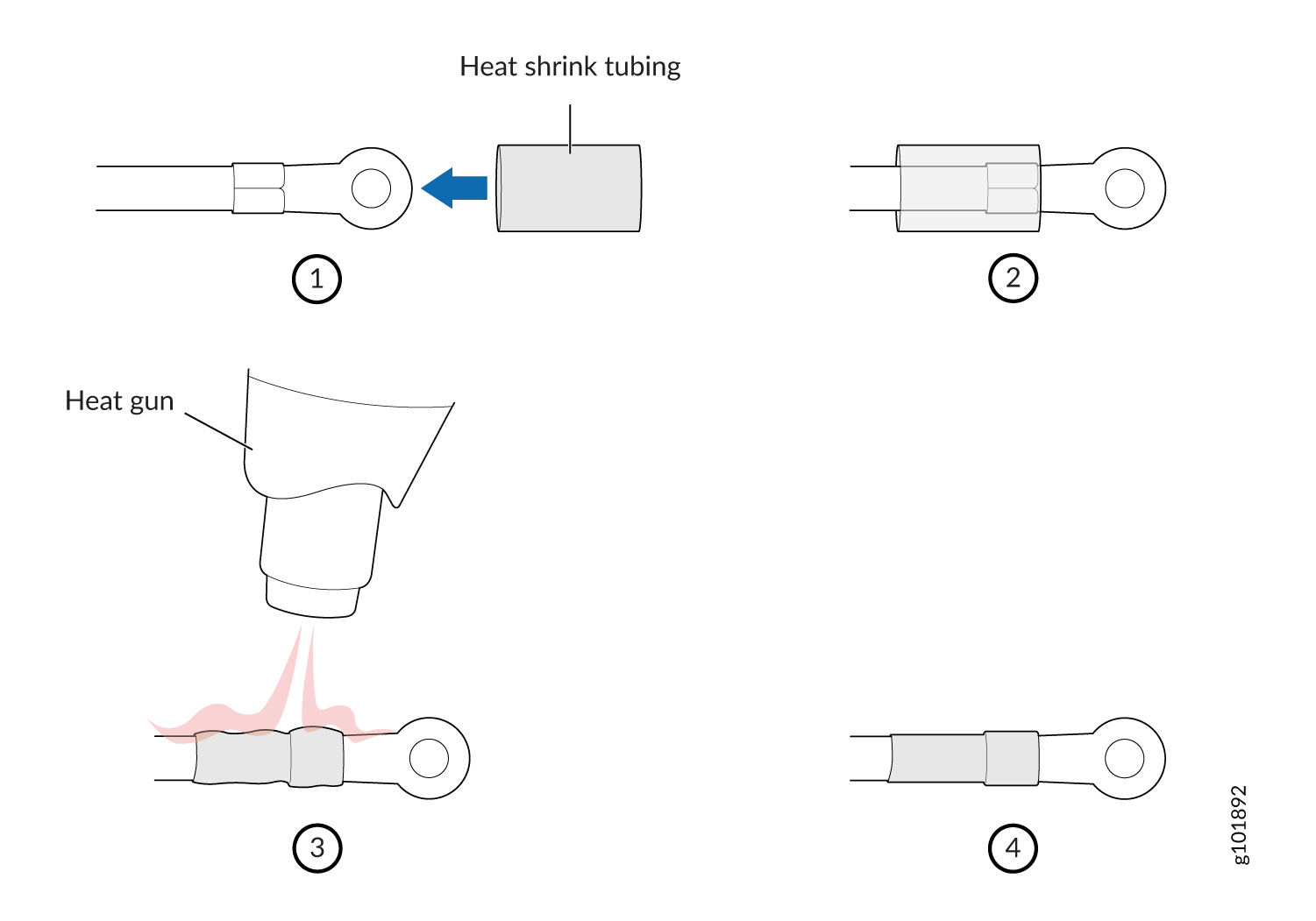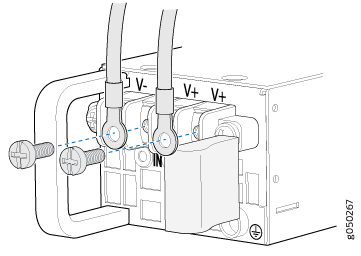Connecting the QFX5110 to Power
Connect the QFX5110 to Earth Ground
You must install the QFX5110 in a restricted-access location and ensure that the chassis is always properly grounded. The QFX5110 has a two-hole protective grounding terminal provided on the chassis. See Figure 1. Under all circumstances, use this grounding connection to ground the chassis. For AC-powered systems, you must also use the grounding wire in the AC power cord along with the two-hole grounding lug connection. This tested system meets or exceeds all applicable EMC regulatory requirements with the two-hole protective grounding terminal.
If an external ground connection is required, ensure that a licensed electrician has attached an appropriate grounding lug to the grounding cable that you supply. Using a grounding cable with an incorrectly attached lug can damage the switch (for example, by causing a short circuit).
Mount your switch in the rack or cabinet before attaching the grounding lug to the switch. See Unpacking and Mounting the QFX5110.
Ensure that you have the following parts and tools available:
Grounding cable for your QFX5110 device—The grounding cable must be 14 AWG (2 mm²), minimum 90° C wire, or as permitted by the local code (not provided).
Grounding lug for your grounding cable—The grounding lug required is a Panduit LCD10-10A-L or equivalent (not provided).
Two 10-32 x 0.25 screws with #10 split-lock washers—Two screws and washers are used to secure the grounding lug to the side of the chassis (not provided).
Number 2 screwdriver.
An AC-powered QFX5110 switch chassis gains additional grounding when you plug the power supply in the switch into a grounded AC power outlet by using an AC power cord appropriate for your geographical location. See QFX5110 AC Power Cord Specifications.
To connect earth ground to a QFX5110:
Alternate Method to Ground QFX5110-48S-DC and QFX5110-32Q-DC Systems
Ensure that you have the following parts and tools available to ground the chassis using this method:
M5 pan-head screw x .08 mm with integrated washer (not provided)
M5 lug (not provided)
12 AWG (2.5 mm²) standard wire, 90° C wire or heavier (not provided)
Number 2 screwdriver (not provided)
To connect earth ground to a QFX5110:DC power supply:
Have a licensed electrician attached the M5 grounding lug to the grounding cable that you supply.
CAUTION:Using a grounding cable with an incorrectly attached lug can damage the switch.
Ensure that all grounding surfaces are clean and brought to a bright finish before grounding connections are made.
Connect one end of the grounding cable to a proper earth ground, such as the rack in which the switch is mounted.
Place the grounding lug that is attached to the grounding cable over the protective earthing terminal on the DC power supply.
Use a screwdriver to secure the grounding lug to the protective earthing terminal with a M5 pan-head screw with integrated washer.
Dress the grounding cable and ensure that it does not touch or block access to other device components and that it does not drape where people could trip over it.
We recommend that you connect earth ground to a QFX5110 DC chassis using the Connect the QFX5110 to Earth Ground method. However if you can’t access the chassis using the two-holed grounding lug, you can ground the chassis using the DC protective earthing terminal on the DC power supply.
The DC power supplies have a protective earthing terminal on the face that holds an M5 pan-head screw with integrated washer. See Figure 2.
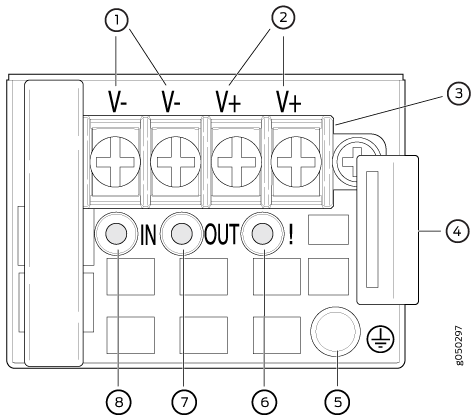
1 — Shunt negative input terminals (-48V) | 5 — Protective earthing terminal |
2 — Shunt positive input terminals (+RTN) | 6 — Fault LED |
3 — Terminal block | 7 — Output LED |
4 — Security latch | 8 — Input LED |
Connecting AC Power to a QFX5110
Ensure that you have a power cord appropriate for your geographical location available to connect AC power to the switch.
Before you begin connecting AC power to the switch:
Ensure that you have taken the necessary precautions to prevent electrostatic discharge (ESD) damage (see Prevention of Electrostatic Discharge Damage).
Ensure that you have connected the switch chassis to earth ground.
CAUTION:Before you connect power to the switch, a licensed electrician must attach a cable lug to the grounding and power cables that you supply. A cable with an incorrectly attached lug can damage the switch (for example, by causing a short circuit).
To meet safety and electromagnetic interference (EMI) requirements and to ensure proper operation, you must connect the chassis to earth ground before you connect it to power. For installations that require a separate grounding conductor to the chassis, use the protective earthing terminal on the switch chassis to connect to the earth ground. For instructions on connecting earth ground, see Connect the QFX5110 to Earth Ground.
On AC systems, the switch gains additional grounding when you plug the power supply in the switch into a grounded AC power outlet by using the AC power cord appropriate for your geographical location (see QFX5110 AC Power Supply Description).
CAUTION:Install the power supply in the chassis. For instructions on installing a power supply in a QFX5110, see Installing a Power Supply in a QFX5110.
The QFX5110 is shipped with two 650 W power supplies pre-installed. Each power supply is a hot-removable and hot-insertable field-replaceable unit (FRU) when the second power supply is installed and running. You can install replacement power supplies in the two slots next to the fan modules without powering off the switch or disrupting switch functions.
Each power supply must be connected to a dedicated power source outlet.
To connect AC power to a QFX5110:
Connecting DC Power to a QFX5110
Before you begin connecting DC power to the switch:
Ensure that you have taken the necessary precautions to prevent electrostatic discharge (ESD) damage (see Prevention of Electrostatic Discharge Damage).
Ensure that you have connected the switch chassis to earth ground.
CAUTION:Before you connect power to the switch, a licensed electrician must attach a cable lug to the grounding and power cables that you supply. A cable with an incorrectly attached lug can damage the switch (for example, by causing a short circuit).
To meet safety and electromagnetic interference (EMI) requirements and to ensure proper operation, you must connect the chassis to earth ground before you connect it to power. For installations that require a separate grounding conductor to the chassis, use the protective earthing terminal on the switch chassis to connect to the earth ground. For instructions on connecting earth ground, see Connect the QFX5110 to Earth Ground.
On DC systems, you can also ground the chassis using the DC protective earthing terminal on the DC power supply as an alternate method. This method is useful if you are unable to access the chassis ground point by using the two-holed grounding lug, see Alternate Method to Ground QFX5110-48S-DC and QFX5110-32Q-DC Systems.
Install the power supply in the chassis. For instructions on installing a power supply in a QFX5110, see Installing a Power Supply in a QFX5110.
Ensure that you have the following parts and tools available:
DC power source cables (14–16 AWG) with ring lug (Molex 190700069 or equivalent) (not provided)
Phillips (+) screwdriver, number 2 (not provided)
Multimeter (not provided)
The QFX5110 is shipped from the factory with two 650 W power supplies. Each power supply is a hot-removable and hot-insertable field-replaceable unit (FRU) when the second power supply is installed and running. You can install replacement power supplies in the two slots next to the fan modules without powering off the switch or disrupting the switching function.
A DC-powered QFX5110 is intended for installation only in a restricted access location.
The battery returns of the DC power supply must be connected as an isolated DC return (DC-I).
To connect DC power to a QFX5110:

